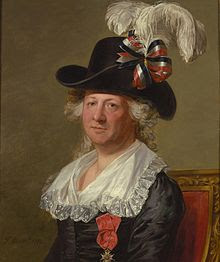
|
| The chevalier, as painted by Thomas Stewart in 1792 |
Does the name Charles-Geneviève-Louis-Auguste-André-Timothée d'Éon de Beaumont ring a bell? Probably not, because writing about this historical figure would require a lot of ink just to spell out the name. Perhaps for that reason, Charles-Geneviève-Louis-Auguste-André-Timothée d'Éon de Beaumont is better known by the name Chevalier d'Éon-- otherwise remembered as the world's first transgendered spy.
Born in Tonnere, France, in 1728, Chevalier d'Éon developed an uncanny talent early in life for impersonating members of either gender, and to this day historians still argue over the chevalier's true gender identity. According to contemporary historians, the chevalier's remarkable talent earned him a position as King Louis XV's top "secret agent".
Sometimes he appeared in public as Chevalier d'Éon, the dashing, daring, debonair swashbuckler, and other times he appeared as a coquettish siren, with the strange ability to make men confide their deepest, darkest secrets. In either case, the chevalier was able to extract the most secret of secrets-- either by brute force or flirtation-- and pass them along to King Louis.
While nobody ever suspected that the dashing swashbuckler and the flirtatious belle were one and the same during his lifetime, it has been said that d'Éon "fought over half of Europe and flirted over the other half." From London to Paris to Rome, the chevalier racked up victory after victory in the game of espionage, ferreting out the most guarded secrets and succeeding where the greatest spies in Europe had failed.
It was at the court of Empress Elizabeth of Russia where the chevalier, in his feminine role, scored his greatest victory for France. At the time Europe was on the verge of the Seven Years' War and King Louis XV was desperate to form an alliance with Russia. France sent diplomat after diplomat to the Imperial Palace in Moscow, but each one returned from Russia with their head bowed in defeat.
As a last resort, King Louis XV sent Charles-Geneviève-Louis-Auguste-André-Timothée d'Éon de Beaumont and within a matter of weeks word reached France that Empress Elizabeth had a new maid of honor who appeared to have a strange hold over the ruler. Rumor had it that the empress' new protege was every bit as charming and intelligent as she was pretty. The empress' newest adviser urged her to contemplate the benefits of forming an allegiance with France and Austria against Frederick the Great. The seed was planted, and all the chevalier had to do was wait. Little by little the empress' resistance crumbled, and two weeks later the chevalier was on his way back to France to give King Louis XV the good news. As a result of the alliance, the map of Europe was forever altered.
In fact, the map of the entire world was re-drawn due to the efforts of the world's most successful androgynous spy, even though the chevalier's side lost the war. By the time the war was over, France ceded its possession of Canada to Great Britain and gave large portions of Louisiana to Spain. Spain, in turn, relinquished its claim to Florida to Great Britain, and the Caribbean islands of St. Vincent, St. Lucia, Tobago and Dominica were divided between Britain and France.
By the time the war had come to an end, the chevalier had grown old, thus making it difficult to perform convincing female impersonations. Yet the chevalier, going by the name Mademoiselle d'Éon, chose to live out the last 33 years of his life as a woman. Because of this, many historians have argued that the chevalier was indeed female. However, doctors who examined d'Éon's body after his death in 1810 discovered normal male organs.